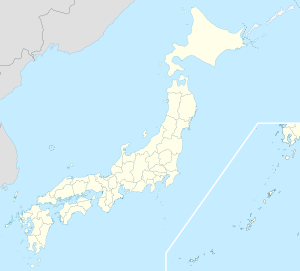Kobe
神戸市 | |
|---|---|
| Kobe City | |
From top left: Kobe Port Tower and Kobe Maritime Museum in Meriken Park, Old Kobe Residency 15th Hall (The Former American Consulate in Kobe) of the Kobe foreign settlement, Hyogo Prefectural Museum of Art, the Chinatown in Nankin-machi, Ikuta Shrine, and a view from Kobe Weathervane House (The Former Thomas House) of Kitano-cho | |
 Interactive map outlining Kobe | |
 Location of Kobe in Hyōgo Prefecture | |
| Coordinates: 34°41′24″N 135°11′44″E / 34.69000°N 135.19556°E | |
| Country | Japan |
| Region | Kansai |
| Prefecture | Hyōgo Prefecture |
| First official record | 201 AD |
| City Status | April 1, 1889 |
| Government | |
| • Mayor | Kizō Hisamoto |
| Area | |
| • Designated city | 557.02 km2 (215.07 sq mi) |
| Population (June 1, 2021) | |
| • Designated city | 1,522,188 (7th) |
| • Metro [1] (2015) | 2,419,973 (6th) |
| Time zone | UTC+9 (Japan Standard Time) |
| Phone number | 078-331-8181 |
| Address | 6-5-1 Kano-chō, Chūō-ku, Kōbe-shi, Hyōgo-ken 650-8570 |
| Climate | Cfa |
| Website | City of Kobe |
| Symbols | |
| Flower | Hydrangea |
| Tree | Camellia sasanqua |
| Kobe | |||||
|---|---|---|---|---|---|
| Japanese name | |||||
| Kyūjitai | 神戶 | ||||
| Shinjitai | 神戸 | ||||
| |||||
Kobe (/ˈkoʊbeɪ/ KOH-bay; Japanese: 神戸, romanized: Kōbe, pronounced [koꜜːbe] ), officially Kobe City (神戸市, Kōbe-shi), is the capital city of Hyōgo Prefecture, Japan. With a population around 1.5 million, Kobe is Japan's seventh-largest city and the third-largest port city after Tokyo and Yokohama. It is located in the Kansai region, which makes up the southern side of the main island of Honshū, on the north shore of Osaka Bay. It is part of the Keihanshin metropolitan area along with Osaka and Kyoto.[2] The Kobe city centre is located about 35 km (22 mi) west of Osaka and 70 km (43 mi) southwest of Kyoto.
The earliest written records regarding the region come from the Nihon Shoki, which describes the founding of the Ikuta Shrine by Empress Jingū in AD 201.[3][4] For most of its history, the area was never a single political entity, even during the Tokugawa period, when the port was controlled directly by the Tokugawa shogunate. Kobe did not exist in its current form until its founding in 1889. Its name comes from Kanbe (神戸, an archaic title for supporters of the city's Ikuta Shrine).[5][6] Kobe became one of Japan's designated cities in 1956.
Kobe was one of the cities to open for trade with the West following the 1853 end of the policy of seclusion and has retained its cosmopolitan character ever since with a rich architectural heritage dating back to the Meiji era. While the 1995 Great Hanshin earthquake diminished some of Kobe's prominence as a port city, it remains Japan's fourth-busiest container port.[7] Companies headquartered in Kobe include ASICS, Kawasaki Heavy Industries, and Kobe Steel, while over 100 international corporations have their Asian or Japanese headquarters in the city, including Eli Lilly and Company, Procter & Gamble, Boehringer Ingelheim, and Nestlé.[8][9] The city is the point of origin and namesake of Kobe beef, the home of Kobe University, and the site of one of Japan's most famous hot spring resorts, Arima Onsen.
- ^ "UEA Code Tables". Center for Spatial Information Science, University of Tokyo. Retrieved January 26, 2019.
- ^ Gabriele Zanatta (April 13, 2016). "Kobe". la Repubblica (in Italian). p. 48.
- ^ Ikuta Shrine official website Archived April 4, 2008, at the Wayback Machine – "History of Ikuta Shrine" (Japanese)
- ^ Kobe City Info Archived June 16, 2008, at the Wayback Machine – "History". Retrieved February 2, 2007.
- ^ Nagasaki University Archived May 16, 2007, at the Wayback Machine – "Ikuta Shrine". Retrieved February 3, 2007.
- ^ Entry for 「神戸(かんべ)」. Kōjien, fifth edition, 1998, ISBN 4-00-080111-2
- ^ American Association of Port Authorities Archived December 21, 2008, at the Wayback Machine – "World Port Rankings 2006". Retrieved April 15, 2008.
- ^ "Number of foreign corporations with headquarters in Kobe passes 100." (Japanese) in Nikkei Net, retrieved from NIKKEI.net Archived July 6, 2007, at the Wayback Machine on July 3, 2007.
- ^ Hyogo-Kobe Investment Guide Archived December 8, 2006, at the Wayback Machine – "List of Foreign Enterprises and Examples". Retrieved February 8, 2007.








